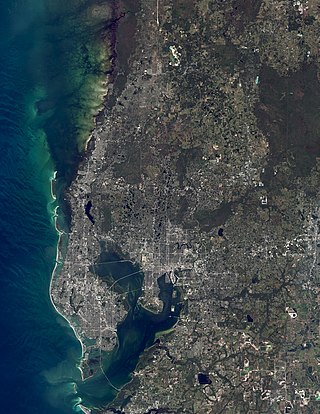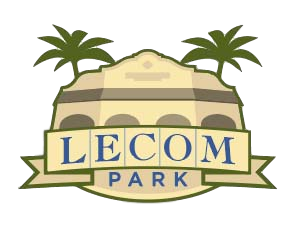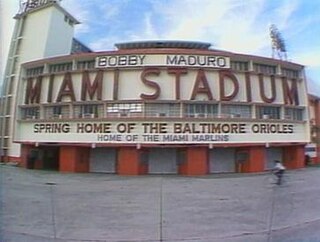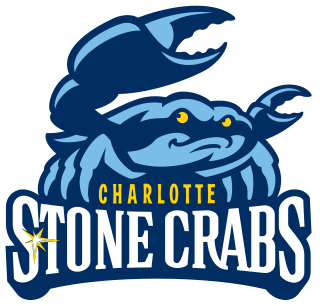
The Tampa Bay area is a major metropolitan area surrounding Tampa Bay on the Gulf Coast of Florida in the United States. It includes the main cities of Tampa, St. Petersburg, and Clearwater. It is the 17th-largest metropolitan area in the United States, with a population of 3,175,275 as of the 2020 U.S. census.

Al Lang Stadium is a 7,500-seat sports stadium along the waterfront of downtown St. Petersburg, Florida, United States which was used almost exclusively as a baseball park for over 60 years. Since 2011, it has been the home pitch of the Tampa Bay Rowdies of the USL Championship soccer league.

George M. Steinbrenner Field, formerly known as Legends Field, is a baseball stadium located in Tampa, Florida, across the Dale Mabry Highway from Raymond James Stadium, the home of the National Football League's Tampa Bay Buccaneers. The ballpark was built in 1996 and seats 11,026 people, with an addition in right field built in 2007. It is the largest spring training ballpark in Florida.

BayCare Ballpark is a baseball stadium located in Clearwater, Florida. The stadium was built in 2004 and has a maximum seating capacity of 8,500 people.

LECOM Park is a baseball field located in Bradenton, Florida. It is the spring training home of the Pittsburgh Pirates and is named after a 15-year naming rights deal was signed with the Lake Erie College of Osteopathic Medicine, which has its main campus in Erie, Pennsylvania, and also a campus in Bradenton. It was formerly known as McKechnie Field, named for Bradenton resident and Baseball Hall of Fame great Bill McKechnie, who led the Pirates in 1925 and the Cincinnati Reds in 1940 to World Series titles. He was also a coach with the Cleveland Indians in 1948.

Al López Field was a spring training and Minor League baseball ballpark in West Tampa, Tampa, Florida, United States. It was named for Al López, the first Tampa native to play Major League Baseball (MLB), manage an MLB team, and be enshrined in the Baseball Hall of Fame. Al López Field was built in 1954 and hosted its first spring training in 1955, when the Chicago White Sox moved their training site to Tampa from California. Al López became the White Sox's manager in 1957, and for the next three springs, he was the home manager in a ballpark named after himself. The Cincinnati Reds replaced the White Sox as Al López Field's primary tenant in 1960 and would return every spring for almost 30 years. The Tampa Tarpons, the Reds' Class-A minor league affiliate in the Florida State League, played at the ballpark every summer from 1961–1987, and many members of the Reds' Big Red Machine teams of the 1970s played there early in their professional baseball careers.

Miami Stadium, later officially known as Bobby Maduro Miami Stadium, was a baseball stadium in Miami, Florida. It was primarily used as the home field of the Miami Marlins minor league baseball team, as well as other minor league teams. It opened in 1949 and held 13,500 people.

Jack Russell Memorial Stadium is a baseball field in Clearwater, Florida. It opened as Jack Russell Stadium in 1955. It was the spring training home of the Philadelphia Phillies Major League Baseball team from 1955 through 2003. Since 2017, it has been home to the Clearwater High School and St. Petersburg College baseball teams.

Snell Isle is a neighborhood in St. Petersburg, Florida, United States that centers on Snell Isle Boulevard. The street is named after local developer C. Perry Snell (1869–1942), a Kentucky druggist who moved to St. Petersburg in 1900 and began buying properties he developed into upscale residential neighborhoods, commercial buildings, and public parks. He was the driving force behind the creation and emergence of the Snell Isle neighborhood in the 1920s. According to an article in Tampa Bay Magazine,
When the development, originally a muddy mangrove island, officially opened in October 1925, only 39 of its 275 acres were above the high tide line. Even so, Snell quickly sold over seven million dollars' worth of lots there.

The St. Petersburg Saints were a minor league baseball team that operated out of St. Petersburg, Florida. The team began as a semi-pro team and as early as October 1908, the semi-pro Saints played the Cincinnati Reds in a post-season exhibition game. By 1914, the Saints were receiving regular coverage in the local press.

The Tampa Bay Rays are an American professional baseball team based in the Tampa Bay area. The Rays compete in Major League Baseball (MLB) as a member club of the American League (AL) East Division. They are one of two major league clubs based in Florida, alongside the National League (NL)’s Miami Marlins. Starting in 2025, the team's home ballpark will be George M. Steinbrenner Field in Tampa, Florida, due to damage to Tropicana Field, their home in St. Petersburg, Florida, from 1998 to 2024, caused by Hurricane Milton.

The Charlotte Stone Crabs were a Minor League Baseball team located in Port Charlotte, Florida, from 2009 to 2020. They competed in the Florida State League (FSL) as the Class A-Advanced affiliate of the Tampa Bay Rays Major League Baseball (MLB) team. They played their home games at Charlotte Sports Park and were named for the Florida stone crab, which is indigenous to the Charlotte County region.

The Tampa Bay area is home to many sports teams and has a substantial history of sporting activity. Most of the region's professional sports franchises use the name "Tampa Bay", which is the name of a body of water, not of any city. This is to emphasize that they represent the wider metropolitan area and not a particular municipality and was a tradition started by Tampa's first major sports team, the original Tampa Bay Rowdies, when they were founded in 1975.

Clearwater Athletic Field was a stadium in Clearwater, Florida. It was first used by professional baseball teams for spring training in 1923 and was the Phillies' first spring training ballpark in Clearwater. The grandstand sat approximately 2,000 and bleachers increased capacity to close to 3,000. Home plate was located on Pennsylvania Avenue, which ran south to north along the third base line, near Seminole Street. Left field ran parallel to Palmetto Street, and right field ran parallel to Greenwood Ave. The grandstand was destroyed by fire in April 1956.

Northeast High School is a public high school in St. Petersburg, Florida. The school is part of the Pinellas County Schools district. Located just across the street from Meadowlawn Middle School and east of John M. Sexton Elementary School, Northeast High School is one of the main high schools in the Saint Petersburg area. The school mascot is the Viking and the school colors are scarlet, cream, and black. Northeast High School is commonly referred to as NEHI.
Albert Fielding Lang (1870–1960), better known as Al Lang, was an American businessman and politician who served as the mayor of St. Petersburg, Florida from 1916 to 1920. Lang was an active mayor who took steps to beautify the city and increase its popularity especially among northerners who would come to Florida in the winter. However, Lang is best known for his work in bringing baseball spring training to the St. Petersburg area.
The Tampa Bay Rays are an American professional baseball team based in St. Petersburg, Florida. They compete in Major League Baseball (MLB) as a member of the American League (AL) East division. Since its inception, the team's home venue has been Tropicana Field.

Grant Field was a baseball stadium located in Dunedin, Florida. It was the longtime home of Dunedin amateur baseball and the first spring training home of the Toronto Blue Jays, as well as home to the Dunedin Blue Jays of the Class A Florida State League. It was closed in 1989 and replaced with TD Ballpark built on the same site.
















